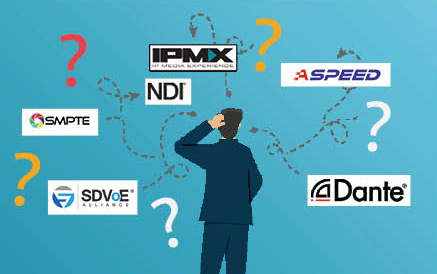AVoIP Standards: The Fight to Get It Right
How do you know which standard is the best standard for your application?

It never hurts to do a side-by-side comparison with various manufacturers on the market. Compare the pricing, features, warranty, support, and availability. Never believe the marketing jargon—believe the results of your own testing and due diligence.
The AV-over-IP market has been growing year after year, deeply impacting how AV is distributed. Products come in a variety of flavors addressing many applications. However, to date, all fall short addressing the full spectrum of a one, true "go-to" standard.

Sometimes, we must be critical of what we have to achieve what we really want. In fairness, to all the up-and-coming AVoIP standards, it takes a lot of time, money, and development to become the dominate standard.
[Is AVoIP at a Tipping Point? One Man's Opinion]
Currently, MPEG (H.264/265), SMPTE ST 2110, NDI, SDVoE, IPMX, Dante, and ASPEED (popular ASIC used in many products) exist. These are a combination of transport and codecs, not to be confused with each other. The transport protocol will manage the communications, timing, and more in relation with the codec. The codec is the compression technique that will ultimately determine the bandwidth and quality of the image.
The Importance of Interoperability
There are a variety of manufacturers with technologies that are proprietary in nature and can only be used by those specific manufacturers, making interoperability with other brands impossible. They all have value—not negating that fact—but the focus here is standards.
[AV-over-IP for Enterprise Organizations]
A daily selection of features, industry news, and analysis for AV/IT professionals. Sign up below.
While a standard could be defined by majority market share, interoperability between different brands allows more choice, better cost, innovation, and overall sustainability. The VHS vs. Beta format war is a great example. Betamax (proprietary to Sony) was better overall, but VHS was licensed to a vast amount of manufacturers, which resulted in lower cost to the consumer with a larger variety of choices. In the end, VHS became the dominate choice.

What makes the ultimate AVoIP standard? All you need is interoperability, no compression to very high compression for operation on any network bandwidth, low to no latency, near perfect image and audio quality, encryption, security, USB/RS-232/IR/CEC control, timing accuracy between different units, scaling, videowall modes, image rotation, seamless switching, windowing, remote previewing, OSD, backward compatibility, and the use of standard communication practices for the control and device protocol. Simple, right?
Interoperability between different brands allows more choice, better cost, innovation, and overall sustainability.
Moving forward, simultaneous low and high bandwidth will also be an important feature to bridge the remote workforce with the facility (unified communications). This is where H.264/.265 will shine, as locally high quality and low latency is necessary, while the remote user will need the lower bandwidth for the internet connection.
While this all sounds like the kid in the proverbial candy store, it does solve most issues across multiple markets. Broadcast, corporate, residential, digital signage, government, and medical currently focus on their specific needs—but it should not have to be segmented this way. One unified standard could open new innovations and capabilities to which each market has never been exposed. Often, the reason AVoIP seems intimidating is the rules each different standard requires on the network, as well as the protocols to control them.
On The Menu
Let’s look at what is currently available. They all have their pros and cons. Below is a brief list only—I encourage you to research deeper into the full specification to reveal how it may or may not impact your application.
MPEG (H.264, H.265): Very low bandwidth (typically utilized on 10/100 networks), it's great for internet transmission and recording. Long latency and poor image quality compared to others. Focused on audio and video.
SMPTE ST 2110: Broadcast centric, it focuses on better video quality at low latencies, however, it lacks the interoperability expected of a standard, as it has no session defined protocol, no encryption, and no transport control channels.
NDI: Developed by NewTek, this is a mid-compression, low-latency transport and codec. Mainly used in the broadcast industry, it has started to work its way into commercial AV using cameras as the means to gain traction. Good interoperability, but lacks the transport control channels and the higher quality video.
SDVoE: Focused only on 10G infrastructure, it delivers high-quality encrypted AV with no frame latency (100us) in a low power ASIC. Feature rich with video wall, windowing, scaling, and more. Transport control channels for RS-232, USB, and IR. Highly interoperable, but limited by a lack of 1G infrastructure capability.
IPMX: Focused on 1G to 25G, it uses the SMPTE ST 2110 and JPEG XS standards to achieve its current results. It supports transport control channels, encryption, and playback on computers. Depending on the partner, the video wall and other advanced features can vary. Currently only on FPGA, which makes it more costly and power hungry.
Dante AV: Continuing to build on its popular audio standard, it is currently focused on the 1G distribution space. Based on the IntoPix JPEG 2000 standard, it currently requires use of an FPGA, so it is costly and power hungry. It has transport control channels, but lacks the features other standards have and has a limited adoption due to current global supply chain issues.
ASPEED: On its third generation ASIC, ASPEED is known for its low-cost, full-featured 1G transport/codec. Image quality, latency, and feature set are extremely good. ASPEED is listed as a standard because of its popularity in the low-cost, low-power consumption market. It does lack interoperability between manufacturers that other standards have and is focused currently on 1G market.
FPGA vs. ASIC: What is important is not the breakdown of the differences, just the result to the product(s). For an AVoIP standard to be successful, it will be necessary to be available in an ASIC form. ASIC uses less power and costs less, leading to better adaptation in a variety of products. FPGA, while very flexible, has a high cost and a very high power consumption.
For example, SDVoE’s ASIC uses as little as 2 watts of power. When this standard first started as an FPGA, it was more than 12 watts. That is a lot of heat to put in a flat panel display or some other type of device, making it more difficult to have as a base feature.
So many choices, what does one do? The answer is easy. Evaluate the requirement of the application and use the standard that best suits the project. It will be years before there is one true standard that rises above the rest. Until that time, there are plenty of great choices.
Paul Harris is the CEO of Aurora Multimedia.

